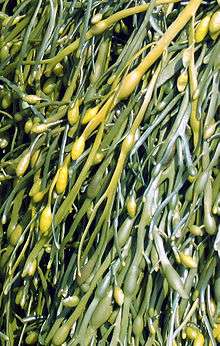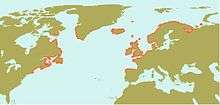Ascophyllum
Ascophyllum nodosum is a large, common cold water seaweed or brown alga (Phaeophyceae) in the family Fucaceae, being the only species in the genus Ascophyllum. It is a seaweed that only grows in the northern Atlantic Ocean, also known in localities as feamainn bhuí, rockweed, Norwegian kelp, knotted kelp, knotted wrack or egg wrack. It is common on the north-western coast of Europe (from Svalbard to Portugal) including east Greenland[1] and the north-eastern coast of North America, its range further south of these latitudes being limited by warmer ocean waters.[2]
| Ascophyllum | |
|---|---|
 | |
| Scientific classification | |
| Kingdom: | Chromista |
| Phylum: | Ochrophyta |
| Class: | Phaeophyceae |
| Order: | Fucales |
| Family: | Fucaceae |
| Genus: | Ascophyllum Stackhouse, 1809 |
| Species: | A. nodosum |
| Binomial name | |
| Ascophyllum nodosum | |
 | |
| Distribution | |
Description
Ascophyllum nodosum has long tough and leathery fronds,[3] irregularly dichotomously branched [4]fronds with large, egg-shaped air bladders set in series at regular intervals along the fronds and not stalked. The fronds can reach 2 m in length and are attached by a holdfast to rocks and boulders. The fronds are olive-green,[5] olive-brown in color and somewhat compressed, but without a midrib.[6]
Reproduction
Its life history is of one diploid plant and gametes. Each individual plant is either male or female.[3] The gametes are produced in the spring[3] in conceptacles embedded in yellowish receptacles on short branches.[2][7]
Varieties and forms
Several different varieties and forms of this species have been described.
- Ascophyllum nodosum var. minor has been described from Larne Lough in Northern Ireland.[8]
Free-floating forms of this species are found in, for example, A. n. mackaii Cotton, which is found at very sheltered locations, such as at the heads of sea lochs in Scotland and Ireland.[9][10]
Ecology
Ascophyllum nodosum is found mostly on sheltered sites on shores in the midlittoral, where it can become the dominant species in the littoral zone.[11][12]
The species is found in a range of coastal habitats from sheltered estuaries to moderately exposed coasts, and often it dominates the intertidal zone (although subtidal populations are known to exist in very clear waters). However, it is rarely found on exposed shores, and if it is found, the fronds are usually small and badly scratched. This seaweed grows quite slowly, 0.5% per day, carrying capacity is about 40 kg wet weight per square meter, and it may live for 10–15 years. It may typically overlap in distribution with Fucus vesiculosus and Fucus serratus. Its distribution is also limited by salinity, wave exposure, temperature, desiccation, and general stress.[13][14][15] It may take approximately five years before becoming fertile.
Phlorotannins in A. nodosum act as chemical defenses against the marine herbivorous snail, Littorina littorea.[16]
Polysiphonia lanosa (L.) T.A. Christensen is a small red alga, commonly found growing in dense tufts on Ascophyllum whose rhizoids penetrate the host.[17] It is considered by some as parasitic; however, as it only receives structural support from knotted wrack (not parasitically), it acts as an epiphyte.
Distribution
This species has been recorded in Europe from Ireland, the Faroe Islands,[19] Norway,[20] Britain and Isle of Man,[21] Netherlands,[22] and North America from the Bay of Fundy, Nova Scotia, Baffin Island, Hudson Strait, Labrador, and Newfoundland.[1][2] It has been recorded as an accidental introduction near San Francisco, California, and eradicated as a potential invasive species.[23]
Uses
Ascophyllum nodosum is harvested for use in alginates, fertilisers, and the manufacture of seaweed meal for animal and human consumption.[24] It has long been used as an organic and mainstream fertilizer for many varieties of crops due to its combination of both macronutrients, (N, P, and K) and micronutrients (Ca, Mg, S, Mn, Cu, Fe, Zn, etc.). It also contains cytokinins, auxin-like gibberellins, betaines, mannitol, organic acids, polysaccharides, amino acids, and proteins which are all very beneficial and widely used in agriculture.[25] Ireland, Scotland and Norway have provided the world's principal alginate supply.[26][27]
Ascophyllum nodosum is frequently used as packaging material for baitworm and lobster shipments from New England to various domestic and international locations.[28] Ascophyllum itself has occasionally been introduced to California, and several species frequently found in baitworm shipments, including Carcinus maenas and Littorina saxatilis, may have been introduced to the San Francisco Bay region this way.[28]
Chemistry
Ascophyllum nodosum contains the phlorotannins tetraphlorethol C and tetrafucol A.[31]
Harvesting controversy
Controversy exists over impacts of commercial harvesting of A. nodosum for use in garden or crop fertilizers and livestock feed supplements in North America and Europe. Some research has been focused on bycatch and impact on intertidal zone communities. [32] Opponents of its wild harvest point to the algae's high habitat value for over 100 marine species,[33] including benthic invertebrates, [34] commercially important fish,[35] wild ducks,[36] shorebirds,[37] and seabirds.[38] Shoreland owners in Maine, as well as federal, state, and local agencies in the United States, have placed their conservation lands off limits to rockweed removal.[39][40] Rockweed harvesters point to the value of the seasonal jobs created by the harvest operation, and also highlight the differences in impact of different harvesting methods such as machine v hand harvesting.[41]
References
This article incorporates CC BY-2.5 text from the reference[28]
- M. D. Guiry & Wendy Guiry (2006-11-23). "Ascophyllum nodosum (Linnaeus) Le Jolis". AlgaeBase.
- W. R. Taylor (1962). Marine Algae of the Northeastern Coast of North America. Ann Arbor, University of Michigan Press. ISBN 978-0-472-04904-2.
- Bunker, F.StP., Maggs, C.A., Brodie, J.A. and Bunker, J.A. 2017. Seaweeds of Britain and Ireland. Second Edition. Wild Nature Press, Plymouth, UK. ISBN 978-0-9955673-3-7
- Newton, L. 1931. A Handbook of the British Seaweeds. British Museum, London
- Harvey, W.H. 1841. A Manual of the British Algae: London, John van Voorst, London
- S. Hiscock (1979). "A field key to the British brown seaweeds (Heterokontophyta)". Field Studies. 5: 1–44.
- H. Stegenga, J. J. Bolton & R. J. Anderson (1997). Seaweeds of the South African West Coast. Bolus Herbarium Humber 18, University of Cape Town. ISBN 978-0-7992-1793-3.CS1 maint: uses authors parameter (link)
- M. J. Lynn (1949). "A rare alga from Larne Lough". Irish Naturalists' Journal. 9: 301–304.
- D. C. Gibb (1957). "The free-living forms of Ascophyllum nodosum (L.) Le Jol". Journal of Ecology. 45 (1): 49–83. doi:10.2307/2257076. JSTOR 2257076.
- O. Morton (2003). "The marine macroalgae of County Donegal, Ireland". Bulletin of the Irish Biogeographical Society. 27: 3–164.
- O. Morton (1994). Marine Algae of Northern Ireland. Ulster Museum, Belfast. ISBN 978-0-900761-28-7.
- J. R. Lewis (1964). The Ecology of Rocky Shores. English Universities Press, London.
- Schonbeck, M. W.; Norton, T. A. (1980). "Factors controlling the lower limits of fucoid algae on the shore". J. Exp. Mar. Biol. Ecol. 43 (2): 131–150. doi:10.1016/0022-0981(80)90021-0.
- Seip, K. L. (1980). "A mathematical model of competition and colonization in a community of marine benthic algae". Ecological Modelling. 10 (2): 77–104. doi:10.1016/0304-3800(80)90065-4.
- Seip K. L. "Mathematical models of rocky shore ecosystems". In: Jørgensen S. E. & Mitch W J. (Eds.) Application of ecological modelling in environmental management, Part B, Chap 13, pp 341-433.
- Geiselman, J. A.; McConnell, O. J. (1981). "Polyphenols in brown algae Fucus vesiculosus and Ascophyllum nodosum: Chemical defenses against the marine herbivorous snail, Littorina littorea". Journal of Chemical Ecology. 7 (6): 1115–1133. doi:10.1007/BF00987632. PMID 24420835.
- C. A. Maggs (1993). Seaweeds of the British Isles. Vol. I: Rhodophyta. Part 3A. Natural History Museum, London. ISBN 978-0-11-310045-3.
- "Knotted Wrack (Ascophyllum nodosum)".
- F. Børgesen (1903). Botany of the Færöes Part II, pp. 339-532. Det nordiske Forlag Ernst Bojesen, Copenhagen.
- F. E. Round (1981). The Ecology of Algae. Cambridge University Press Cambridge. ISBN 978-0-521-22583-0.
- F. G. Hardy & M. D. Guiry (2006). A Check-list and Atlas of the Seaweeds of Britain and Ireland. British Phycological Society, London. ISBN 978-3-906166-35-3.
- H. Stegenga, I. Mol, W. F. Prud'homme van Reine & G. M. Lokhorst (1997). "Checklist of the marine algae of the Netherlands". Gorteria. supplement. 4: 3–57.CS1 maint: uses authors parameter (link)
- A. W. Miller; A. L. Chang; N. Cosentino-Manning; G. M. Ruiz (2004). "A new record and eradication of the north Atlantic alga Ascophyllum nodosum (Phaeophyceae) from San Francisco Bay, California, USA". Journal of Phycology. 40 (6): 1028–1031. doi:10.1111/j.1529-8817.2004.04081.x.
- "Production, Trade and Utilization of Seaweeds and Seaweed Products".
- J. Norrie & D. A. Hiltz (1999). "Seaweed Extract Research and Applications in Agriculture". Agro Food Industry Hi-tech.
- L. G. Lewis, N. F. Stanley & G. G. Guist (1988). "Commercial production and applications of algal hydrocolloides". In C. A. Lembi & J. R. Waaland (ed.). Algae and Human Affairs. Cambridge University Press, Cambridge. ISBN 978-0-521-32115-0.CS1 maint: uses authors parameter (link)
- M. D. Guiry & D. J. Garbary (1991). "Geographical and Taxonomic guide to European Seaweeds of Economic Importance". In M. D. Guiry & Blunden (ed.). Seaweed Resources in Europe: Uses and Potential. John Wiley & Sons, England. ISBN 978-0-471-92947-5.
- Chang, A. L.; Blakeslee, A. M. H.; Miller, A. W.; Ruiz, G. M. (2011). "Establishment Failure in Biological Invasions: A Case History of Littorina littorea in California, USA". PLoS ONE. 6 (1): e16035. Bibcode:2011PLoSO...616035C. doi:10.1371/journal.pone.0016035. PMC 3018467. PMID 21264336.
- Seip, K.L. (1979). "A mathematical model for the uptake of heavy metals in benthic algae". Ecological Modelling. 6 (3): 183–197. doi:10.1016/0304-3800(79)90012-7.
- Melhus, A.; Seip, KL; Seip, HM; Myklestad, S. (1978). "A preliminary study of the use of benthic algae as biological indicators of heavy metal pollution in Sørfjorden, Norway". Environ. Pollut. 15 (2): 101107. doi:10.1016/0013-9327(78)90099-X.
- Wang Y (2008). "Effects of phlorotannins from Ascophyllum nodosum (brown seaweed) on in vitro ruminal digestion of mixed forage or barley grain". Animal Feed Science and Technology. 145: 375–395. doi:10.1016/j.anifeedsci.2007.03.013.
- T. Trott & P.F. Larsen (2008) Evaluation of short-term changes in rockweed (Ascophyllum nodosum) and associated epifaunal communities following cutter rake harvesting in Maine. "Archived copy" (PDF). Archived from the original (PDF) on 2012-10-13. Retrieved 2011-07-14.CS1 maint: archived copy as title (link) Maine Department of Marine Resources Retrieved 2011-07-13
- "Six plans approved for Cobscook Bay rockweed harvest". The Quoddy Tides. March 25, 2011. Archived from the original on October 6, 2011. Retrieved 2011-03-23.
- P. Larsen (2010). "The Macroinvertebrate Fauna of Rockweed (Ascophyllum nodosum)–Dominated Low-Energy Rocky Shores of the Northern Gulf of Maine". Journal of Coastal Research. 279: 36–42. doi:10.2112/JCOASTRES-D-10-00004.1.
- "Gulf of Maine Rockweed Conference Notes". Retrieved 2011-03-23.
- B. M. Blinnabd; A. W. Diamonda; D. J. Hamiltonac (2008). "Factors Affecting Selection of Brood-rearing Habitat by Common Eiders (Somateria mollissima) in the Bay of Fundy, New Brunswick, Canada". Waterbirds. 31 (4): 520–529. doi:10.1675/1524-4695-31.4.520.
- L. Tudor (2000). "Migratory Shorebird Assessment" (PDF). Maine Department of Inland Fisheries and Wildlife. Archived from the original (PDF) on 2012-10-12. Cite journal requires
|journal=(help) - "Life Within the Rockweed". The Quoddy Tides. September 22, 2000. Archived from the original on September 8, 2008. Retrieved 2011-03-24.
- "Rockweed harvest in question this year". Bangor Daily News. June 29, 2010. Archived from the original on January 17, 2013. Retrieved 2011-03-24.
- "The Rockweed Coalition, Maps". Retrieved 2011-03-24.
- Acadian Seaplants Limited. "2011 Rockweed Harvest Plan for Cobscook Bay, Maine" (PDF). Retrieved 2011-03-23.
External links
| Wikimedia Commons has media related to Ascophyllum nodosum. |
- M.D. Guiry & G.M. Guiry (2009). "Knotted wrack Ascophyllum nodosum". AlgaeBase: listing the world's algae. Galway: AlgaeBase.
- J. M. Hill & N. White (2007). "Knotted wrack Ascophyllum nodosum". Marine Life Information Network: Biology and Sensitivity Key Information Sub-programme. Plymouth: Marine Biological Association of the United Kingdom.
- O. Morton. "Ascophyllum nodosum — knotted wrack". Priority species in Northern Ireland. Ulster Museum. Retrieved 2007-01-30.
